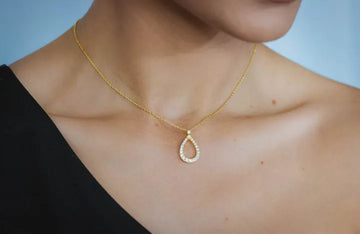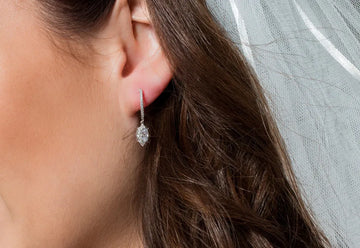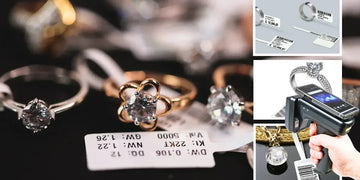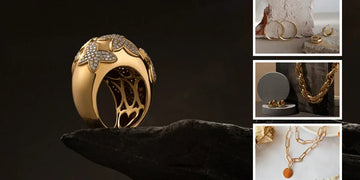The world is moving fast, and so is the jewellery industry, which means there are challenges in the market, and there is also a need for progress in this fast-moving sector.
One solution that has revolutionised the way jewellery stores do business is the RFID (Radio Frequency Identification) technology.
This ‘smart’ technology has revolutionised the way Jewellery Stores operate globally, allowing owners to monitor stock, enhance customer service, and minimise theft.
This article will discuss how RFID is changing the game for the jewellery market by making it more efficient whilst also turning a profit.
What is RFID Technology and How Does It Work in Jewellery Stores?
RFID is short for Radio Frequency Identification. It is a wireless technology for handling different objects, such as RFID Tags, which are attached to objects to transfer information.
In the jewellery trade, RFID tags are tiny electronic labels affixed to each piece. These tags hold key details like the item's name, price, design, and even where in the store it can be found.

RFID readers sweep the tags and automatically download all this information so that storekeepers can easily monitor their inventory.
RFID readers are different from classic bar code readers in that they don’t require you to “see” the tags presented for reading. That means they can read more than one tag at a time, including those behind displays or packages.
This makes RFID technology faster and more effective than traditional tracking systems.
Key Benefits of Using RFID in Jewellery Stores
The use of RFID technology in jewellery stores offers several benefits that help businesses run more smoothly and profitably:
Real-Time Inventory Tracking
With RFID jewellery, stores can track every single piece in real time. This way, store owners always know what products they have in stock and where they are in the store.
Stock checking can easily be done, and the potential for errors from human errors with manual checks is minimised significantly.
Improved Security
RFID provides better security for jewellery items. If a piece of jewellery leaves its area without being purchased, it triggers RFID sensors that alert staff. This significantly reduces the chances of theft and helps keep valuable items safe.

Faster Service and Better Customer Experience
By utilising the RFID technology, times required for stock inventory are shortened and products can be immediately identified at the point of sale.
This all adds to the process acceleration which means your staff can spend more time with customers, enhancing their shopping experience as they do so.
Reduced Errors and Mistakes
Traditional inventory systems like barcode scanning tend to be error-prone, particularly when dealing with small elements like jewelry.
RFID reduces manual errors; inventory can be captured in near real-time and is always accurate and updated.
Data-Driven Decision Making
RFID systems acquire valid data for the decision-making process. For instance, jewellery store owners can see which item is most popular, learn what the customers prefer, and treat their inventory restock better.
RFID in the Jewellery Store: How It Works
To set up an RFID system in a jewellery store, several components are needed:
-
RFID Tags: These small labels are attached to each piece of jewellery and contain unique identification information about the piece.
-
RFID Readers: These devices scan the RFID tags and collect their data.
-
Antennas: These are placed around the store to pick up the signals from the RFID tags.
-
Software System: This is the central control system that links the RFID hardware with the store’s inventory management system, ensuring that the stock levels are always updated in real-time.
With this setup, store owners can track every item from when it enters the store to when it is sold, providing full visibility of the stock at all times.

RFID vs. Traditional Barcodes: Why RFID Wins
While barcode technology has been the standard for tracking items in retail for many years, RFID offers several key advantages:
No Line of Sight Needed
RFID, unlike barcodes, does not need a direct line of sight to read the tag. This allows RFID readers to read several items simultaneously, whether they’re in display cases or tucked out of sight.
Faster Scanning
RFID technology can pass over 1000 items at a time, while the bar code reader reads one item at a time. This kind of speed assists jewellery stores in doing stock-takes and inventory reconciliations much faster.
Real-Time Updates
When an item changes hands, is sold or restocked with RFID systems, location data is updated on the spot. This way, you can rest assured that the stock is kept up to date and that you don’t run out of stock or oversell.
Better Security
RFID tags are traceable across the store, and if there's any abnormal movement, it will be picked up. This level of security doesn’t exist with barcode systems, which cannot be set to notify staff if an item is moved off the shelf or stolen without being scanned.
Long-Term Cost Savings
Although implementing an RFID system can mean an initial investment of a little more, the long-term benefits are worth the price. RFID reduces labor costs, enhances accuracy, and increases throughput, resulting in higher profits over time.
Types of RFID Tags for Jewellery
Jewellery items come in various sizes and materials, so different types of RFID tags are used depending on the item:
UHF Passive Tie Tags
These tiny, lightweight tags are perfect for small jewellery items such as rings and earrings. They are economical and conveniently attachable.
Zip-Tie RFID Labels
They come with integrated zip ties, so they are ideal for connecting to and detaching from the more delicate items. They are widely used in Jewellery stores for heavily handled stock.
Active RFID Tags
These battery-powered tags can transmit signals over longer distances. They are employed for high-value or high-risk jewellery and enable advanced tracking functionality.
Real-Life Applications of RFID in Jewellery Stores
Many jewellery stores are already benefiting from RFID technology in various ways:
Faster Inventory Checks
Stock checks can be carried out quickly through RFID. Instead of hand-counting through each item, staff members can scan thousands in minutes, saving time and reducing errors.

Real-Time Tracking
RFID readers positioned throughout the store offer live updates regarding the whereabouts of each item. If a piece of jewellery is disturbed or taken away, the system can immediately notify staff.
Better Checkout Experience
At the checkout, RFID readers can scan all the items in a transaction at once, accelerating billing and minimising the risk of errors.
Enhanced Security
RFID can work as an anti-theft system by installing security gates that determine whether someone is standing there with a product they have not paid for or purchased. This becomes particularly useful in high-quality jewellery.
Streamlined Item Search
RF tags make it easier to locate particular jewelry items. The staff can be told exactly where a piece is, so they won’t have to search through the collection laboriously.
How RFID Helps Jewellery Businesses Sell Online
In today’s digital age, many jewellery businesses are expanding into the online market. RFID technology plays a crucial role in helping stores seamlessly integrate their physical and online operations:
Syncing Inventory
RFID guarantees that stock levels in the brick-and-mortar store are always up to date in the online store. Selling out of stock proves to be manageable this way.
Improving Online Shopping Experience
With RFID, jewellery retailers can provide services such as virtual try-ons or bespoke products on their websites, enhancing the online shopping experience and ensuring its safety.
Global Reach
RFID is an essential tool that assists jewellery retailers in expanding their demographic reach with efficient and accurate stock management, enabling online product sales to consumers worldwide.
Conclusion
RFID technology is transforming the jewellery business by making inventory management faster, more accurate, and more secure.
Jewellery stores that embrace RFID technology can track their stock in real-time, prevent theft, and enhance customer service, all while saving time and money. Whether you are a small boutique or a large retail chain, adopting RFID technology will give your jewellery business a competitive edge in today’s digital world.
As the jewellery industry continues to evolve, stores that stay updated with technological advancements like RFID will have a better chance of thriving in a competitive market.
It’s clear that RFID is the future of jewellery retail, offering a smarter, more efficient, and secure way to manage inventory and protect valuable stock.











